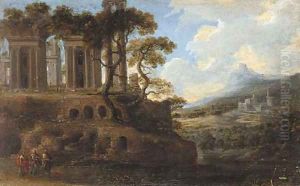Antoine Pierre Patel II Paintings
Antoine Pierre Patel II, often referred to as Pierre Patel the Younger, was a French painter born in 1648 in Paris, France. He was the son of Pierre Patel the Elder, a renowned landscape painter who was a significant influence on his style and career. The Patel family's artistic legacy extended across several generations, contributing notably to French Baroque landscape painting.
Pierre Patel the Younger trained under the guidance of his father and inherited his position as a prominent landscape artist. His works were characterized by their classical composition and often included architectural elements and ruins, which were popular subjects in the French classical landscape tradition. He depicted idyllic scenes inspired by both real and idealized nature, influenced by the works of other landscape artists of his time, such as Nicolas Poussin and Claude Lorrain.
Despite the prominence of his father, Patel II managed to carve out his own niche in the French art scene. He was admitted to the Académie Royale de Peinture et de Sculpture in 1677, which was a significant achievement and recognition of his artistic talents. His admission to the Academy underlines the respect he garnered among his contemporaries and his contribution to the French artistic tradition.
Patel II's works were sought after by art patrons and were collected by members of the French aristocracy. He also worked on various commissions for religious institutions. His landscapes have been noted for their serene and poetic qualities, which embody the classical French landscape tradition of the 17th century. The legacy of the Patel family, including both Pierre Patel the Elder and Pierre Patel the Younger, is reflected in the collections of various museums and continues to be studied for their contribution to French art history.
Pierre Patel the Younger lived and worked in Paris throughout his life and died there in 1707. His death marked the end of an era for the Patel family's artistic dynasty, but his works continue to be appreciated for their beauty and classical elegance.
